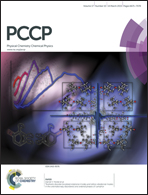Sensing sulfur-containing gases using titanium and tin decorated zigzag graphene nanoribbons from first-principles
Abstract
Atom implantation in graphene or graphene nanoribbons offers a rich opportunity to tune the material structure and functional properties. In this study, zigzag graphene nanoribbons with Ti or Sn adatoms stabilised on a double carbon vacancy site are theoretically studied to investigate their sensitivity to sulfur-containing gases (H2S and SO2). Due to the abundance of oxygen in the atmosphere, we also consider the sensitivity of the structures in the presence of oxygen. Density functional theory calculations are performed to determine the adsorption geometry and energetics, and nonequilibrium Green's function method is employed to compute the current–voltage characteristics of the considered systems. Our results demonstrate the sensitivity of both Ti- and Sn-doped systems to H2S, and the mild sensitivity of Ti-doped sensor systems to SO2. The Ti-doped sensor structure exhibits sensitivity to H2S with or without oxidation, while oxidation of the Sn-doped sensor structure reduces its ability to adsorb H2S and SO2 molecules. Interestingly, oxygen dissociates on the Ti-doped sensor structure, but it does not affect the sensor's response to the H2S gas species. Oxidation prevents the dissociation of the H–S bond when H2S adsorbs on the Ti-doped structure, thus enhancing its reusability for this gas species. Our study suggests the potential of Ti- and Sn-doped graphene in selective gas sensing, irrespective of the sensing performance of the bulk oxides.


 Please wait while we load your content...
Please wait while we load your content...